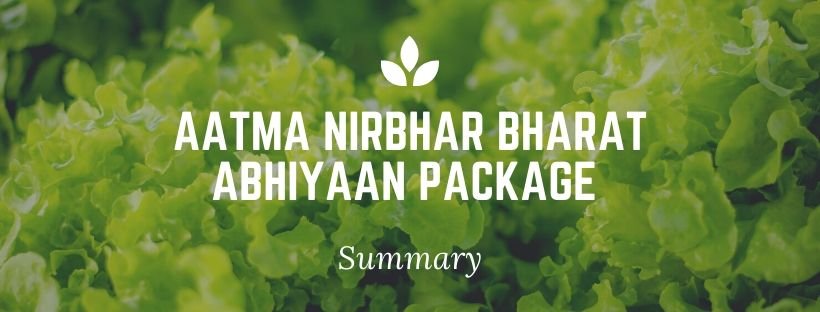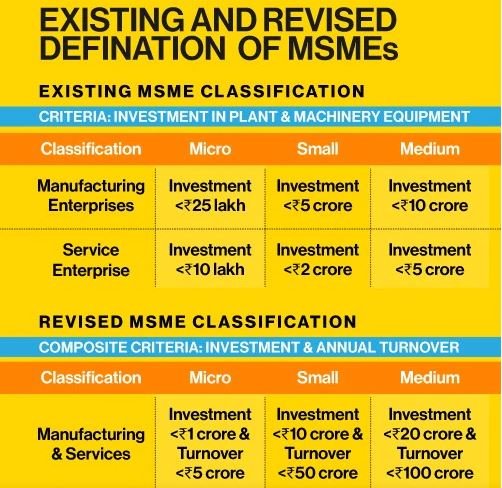Prime Minister of India, Shri. Narendra Modi had announced that Rs 20 lakh crore package will be given to the economy in wake of COVID-19. After this, the Finance Minister of India, Smt. Nirmala Sitharaman, made the announcement regarding this package in 5 shifts.
Name of the Package: Aatma Nirbhar Bharat Abhiyaan Package.
Total outlay of the Package: Rs 20,97,053 Crore.
| Item | Amount of the package (in Rs. Crore) | Subtotal (in Rs. Crore) |
| Tranche 1 (May 13, 2020) | 5,94,550 | 11,02,650 |
| Tranche 2 (May 14, 2020) | 3,10,000 | |
| Tranche 3 (May 15, 2020) | 1,50,000 | |
| Tranche 4 and 5 (May 16 and 17, 2020) | 48,100 | |
| Earlier Measures including PMGKP | 1,92,800 | 9,94,403 |
| RBI Measures (Actual) – like LTRO, TLTRO and TLTRO 2.0 | 8,01,603 | |
| GRAND TOTAL | 20,97,053 | 20,97,053 |
The package was announced on 5 different days from May 13 to May 17, 2020. Each day there was a different sector that was being targetted. In this post, first, we have listed the importance of announcements made on each day followed by only the most important points that are important from the exam point of view.
Five pillars of Atmanirbhar Bharat – Economy, Infrastructure, System, Vibrant Demography and Demand.
Special economic and comprehensive package of Rs 20 lakh crores – equivalent to 10% of India’s GDP
Day 1 (May 13, 2020) – The announced measures focused on Getting back to work i.e., enabling employees and employers, businesses, especially Micro Small and Medium Enterprises, to get back to production and workers back to gainful employment.
Read the announcements made on May 13, 2020
Day 2 (May 14, 2020) – The announcement focusses on short term and long-term measures for supporting the poor, including migrants, farmers, tiny businesses and street vendors.
Read the announcements made on May 14, 2020
Day 3 (May 15, 2020) – The announcement focusses on Infrastructure Logistics, Capacity Building, Governance and Administrative Reforms for Agriculture, Fisheries and Food Processing Sectors.
Read the announcements made on May 15, 2020
Day 4 (May 16, 2020) – The announcement focusses on reforming 8 sectors which are (1) coal, (2) minerals, (3) defence production, (4) airports and airspace management, (5) MRO, (6) power distribution of companies in UTs, (7) space and (8) atomic energy.
Read the announcements made on May 16, 2020
Day 5 (May 17, 2020) – The 5th tranche is focussed on Government Reforms and Enablers for providing employment, support to businesses, Ease of Doing Business, and State Governments as well sectors such as Education and Health. Seven measures have been announced under this.
Read the announcements made on May 17, 2020
Summary of Aatma Nirbhar Bharat Abhiyaan Package
(Only Most Important Points)
From Day 1
New definition of MSME- Definition of MSME will be revised by raising the Investment limit. Additional criteria of turnover also being introduced.
Emergency Credit Line to Businesses/MSMEs from Banks and NBFCs up to 20% of entire outstanding credit as on 29.2.2020- This will be available to units with upto Rs 25 crore outstanding and turnover of up to Rs 100 crore whose accounts are standard.
Rs 20,000 crore Subordinate Debt for Stressed MSMEs- Provision made for Rs. 20,000 cr subordinate debt for two lakh MSMEs which are NPA or are stressed. Government will support them with Rs. 4,000 Cr. to Credit Guarantee Trust for Micro and Small enterprises (CGTMSE).
Govt will set up a Fund of Funds with a corpus of Rs 10,000 crore that will provide equity funding support for MSMEs.
The due date of all Income Tax Returns for Assessment Year 2020-21 will be extended to 30 November 2020.
The TDS rates for all non-salaried payments to residents, and tax collected at source rate will be reduced by 25 percent of the specified rates for the remaining period of FY 20-21. This will provide liquidity to the tune of Rs 50,000 Crore.
The date for making payment without additional amount under the specific scheme will be notified by the Department of Expenditure on the following pattern:
- Unconditional increase of 0.50%
- 1% in 4 tranches of 0.25%, with each tranche linked to clearly specified, measurable and feasible reform actions
- Further 0.50% if milestones are achieved in at least three out of four reform areas
From Day 2
2% Interest Subvention for 12 months for Shishu MUDRA loanees- Relief of Rs. 1,500 crore- Government of India will provide Interest subvention of 2% for prompt payees for a period of 12 months to MUDRA Shishu loanees, who have loans below Rs 50,000.
Rs 5,000 crore Credit facility for Street Vendors- Under this scheme, bank credit facility for initial working capital up to Rs. 10,000 for each enterprise.
Rs 6,000 crore for Creating employment using CAMPA funds- Compensatory Afforestation Management & Planning Authority (CAMPA)
Rs 30,000 crore Additional Emergency Working Capital for farmers through NABARD- NABARD will extend additional re-finance support of Rs 30,000 crore for meeting crop loan requirement of Rural Cooperative Banks and RRBs. This refinance will be front-loaded and available on tap. This is over and above Rs 90,000 crore that will be provided by NABARD to this sector in the normal course.
Rs 2 lakh crore credit boost to 2.5 crore farmers under Kisan Credit Card Scheme.
From Day 3
Rs 10,000 crore scheme for Formalisation of Micro Food Enterprises (MFE)- a new scheme will be launched to help 2 lakh MFEs who need technical up-gradation to attain FSSAI food standards, build brands and marketing.
Rs 20,000 crore for fisherman through Pradhan Mantri Matsya Sampada Yojana (PMMSY)- The Government will launch the PMMSY for integrated, sustainable, inclusive development of marine and inland fisheries. Rs 11,000 crore for activities in Marine, Inland fisheries and Aquaculture and Rs. 9000 crore for Infrastructure – Fishing Harbours, Cold chain, Markets etc shall be provided.
National Animal Disease Control Programme for Foot and Mouth Disease (FMD) and Brucellosis launched with a total outlay of Rs. 13,343 crore to ensure 100% vaccination of cattle, buffalo, sheep, goat and pig population (total 53 crore animals) for Foot and Mouth Disease (FMD) and for brucellosis.
An Animal Husbandry Infrastructure Development Fund of Rs. 15,000 crore will be set up, with an aim to support private investment in Dairy Processing, value addition and cattle feed infrastructure.
Beekeeping initiatives – Rs 500 crore
From ‘TOP’ to TOTAL – Rs 500 crore- “Operation Greens” run by Ministry of Food Processing Industries (MOFPI) will be extended from tomatoes, onion and potatoes to ALL fruit and vegetables. The Scheme would provide 50% subsidy on transportation from surplus to deficient markets, 50% subsidy on storage, including cold storages and will be launched as pilot for the next 6 months and will be extended and expanded.
From Day 4
Make in India for Defence Production- Foreign Direct Investment limit in defence manufacturing under automatic route is being raised from 49% to 74% to boost indigenous defence production.
Social Infrastructure Projects- Boosting private sector investment in social infrastructure projects through a revamped viability gap funding scheme of Rs 8,100 crore. The govt will enhance the quantum of viability gap funding up to 30 per cent each of total project cost as VGF by Centre and state.
From Day 5
Allocation for MGNREGS increased by Rs 40,000 Crore to provide employment boost.
PM eVIDYA– A programme for multi-mode access to digital/online education to be launched immediately; consisting of DIKSHA for school education in states/UTs: e-content and QR coded Energized Textbooks for all grades (one nation, one digital platform).
Manodarpan– An initiative for psychosocial support of students, teachers and families for mental health and emotional wellbeing to be launched immediately.
National Foundational Literacy and Numeracy Mission for ensuring that every child attains Learning levels and outcomes in grade 5 by 2025 will be launched by December 2020.
Minimum threshold to initiate insolvency proceedings raised to Rs. 1 crore (from Rs. 1 lakh, which largely insulates MSMEs). Suspension of fresh initiation of insolvency proceedings up to one year, depending upon the pandemic situation.
List of strategic sectors requiring presence of PSEs in public interest will be notified. In strategic sectors, at least one enterprise will remain in the public sector but private sector will also be allowed. In other sectors, PSEs will be privatized (timing to be based on feasibility etc.)
States net borrowing ceiling for 2020-21 is Rs. 6.41 lakh crores, based on 3% of Gross State Domestic Product (GSDP).
Centre has decided to increase borrowing limits of States from 3% to 5% for 2020-21 only. This will give States extra resources of Rs. 4.28 lakh crores.
A specific scheme will be notified by the Department of Expenditure on the following pattern:
- Unconditional increase of 0.50%
- 1% in 4 tranches of 0.25%, with each tranche linked to clearly specified, measurable and feasible reform actions
- Further 0.50% if milestones are achieved in at least three out of four reform areas
Summary of Pradhan Mantri Garib Kalyan Package
- Insurance cover of Rs 50 Lakh per health worker.
- 1 kg pulses for each household for free every month for the next 3 months.
- 20 crore women Jan Dhan account holders get Rs 500 per month for the next 3 months.
- Free of cost Gas Cylinder provided to 8 crore poor families for the next 3 months.
- Increase in MNREGA wage to Rs 202 a day from Rs 182
- Ex-gratia of Rs 1,000 to 3 crore poor senior citizen, poor widows and poor Divyang.
- 24% of monthly wages to be credited into their PF accounts for the next 3 months for wage-earners below Rs 15,000 per month in businesses having less than 100 workers.
- 5 crore workers registered under Employee Provident Fund EPF to get a non-refundable advance of 75% of the amount or three months of the wages, whichever is lower, from their accounts.
- Limit of collateral-free lending to be increased from Rs 10 to Rs 20 lakhs for Women Self Help Groups.
Quiz on Aatma Nirbhar Bharat Package (30 Question)


